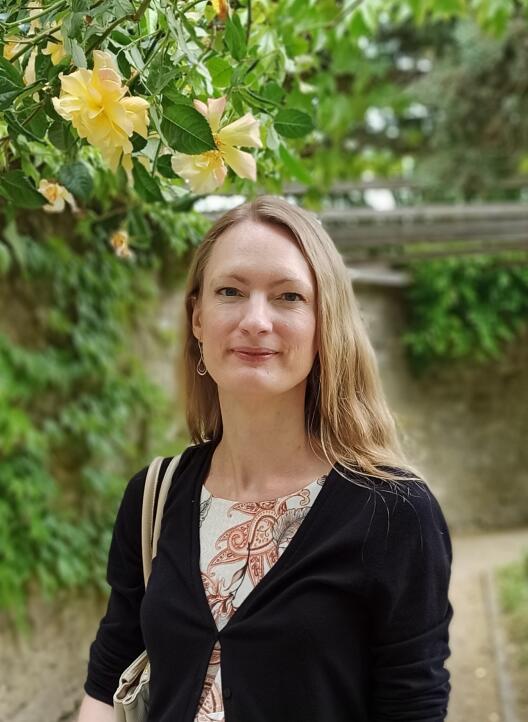
Dr. Volha Bartash
Historisches Seminar
Arbeits- und Lehrbereich Diversität in historischen Gesellschaften
Domplatz 20-22
48143 Münster
Raum F 13d

Historisches Seminar
Arbeits- und Lehrbereich Diversität in historischen Gesellschaften
Domplatz 20-22
48143 Münster
Raum F 13d
Ausbildung und beruflicher Werdegang
Fellowships und Auszeichnungen
2023-2024 Post-Doc Stipendium, Bayerisches Programm zur “Realisierung der Chancengleichheit für Frauen in Forschung und Lehre”
2018-2021 Marie Skłodowska-Curie Individual Fellowship, Horizon 2020
2016-2017 Visby Postdoctoral Scholarship, Swedish Institute
2016 Fellowship, Imre Kertesz Kolleg Jena
2015-2016 Research Fellowship, Wiener Wiesenthal Institut für Holocaust-Studien
2014-2015 Kone Foundation Fellowship
2014 Jeff and Toby Herr Fellowship, United States Holocaust Memorial Museum
2013 Marian Madison Young Scholar's Prize in Romani Studies
Survival as a Daily Routine: Roma in the German-Occupied Belarusian-Lithuanian Border Region, forthcoming with Brill
Papusza. Tears of Blood: A Poet’s Witness Account of the Nazi Genocide of Roma, Paderborn: Brill Schöningh 2024 (with Tomasz Kamusella and Viktor Shapoval)
Special Issue “Memory and Recognition of the Nazi Genocide of Roma in the Baltic context,” Journal of Baltic Studies, Vol. 54 (1) 2023 (with Neringa Latvytė)
“Introduction: Tears of Blood as a Survivor Testimony on the Nazi Genocide of Roma,” In: Volha Bartash, Tomasz Kamusella and Viktor Shapoval (eds.), Papusza. Tears of Blood: A Poet’s Witness Account of the Nazi Genocide of Roma, Paderborn: Brill Schöningh 2024
Introduction: Memory and Recognition of the Nazi genocide of Roma in the Baltic context,” Journal of Baltic Studies, Vol. 54 (1) 2023, 1-6 (with Neringa Latvytė) Link
“Mnemonic Border-Crossings: How Roma Communities from the Baltic Borderlands Remember Their Shared Past,” Journal of Baltic Studies, Vol. 54 (1) 2023, 39-68
“The Memorial to Roma Genocide Victims in Navasyady, Belarus: Shifting Meanings and Mnemonic Communities, History & Memory, Vol. 35 (2) 2023, 39-68
“The Joy and Burden of Living: Roma Communities in the Western Borderlands of the Post-war Soviet Union,” In: Anna Wylegała, Sabine Rutar and Małgorzata Łukianow (eds.) No Neighbors’ Lands in Postwar Europe. Vanishing Others, Palgrave Macmillan 2023, 155-178
Link
“Resistance or Survival? Roma in the Soviet partisan Units: Memories and Archival Evidence,” In: Celia Donert and Eve Rosenhaft (eds.),The Legacies of the Romani Genocide in Europe since 1945, Routledge 2021, 107-124
“The Romani Family before and during the Holocaust – How Much Do We Know? An Ethnographic-Historical Study in the Belarusian-Lithuanian Border Region,” In: Eliyana R. Adler and Katerina Capková (eds.), Jewish and Romani families in the Holocaust and its aftermath, Rudgers University Press 2020, 17-41
“Towards Ethnography of Archival Silence: Romani Memory of Nazi Genocide Confronts the Soviet Records,”La Ricerca Folklorica (Special issue “Archive and Ethnography: The Case of Europe´s Sinti and Roma, 19th-21st cent.”), Vol. 2 (74) 2019, 13-28 Link
“Family Memories of Roma as Sources for Holocaust Studies: Insights from the Belarusian-Lithuanian Border Region,” S:I.M.O.N. – Shoah: Intervention. Methods, Documentation, Vol. 4 (2) 2017, 4-17Link
“Let the Victims Speak. Memories of Belarusian Roma as Sources for Genocide Studies,” In: Alexander Friedman and Rainer Hudemann (Hrsg.), Diskriminiert – vernichtet – vergessen. Behinderte in der Sowjetunion, unter nationalsozialistischer Besatzung und im Ostblock 1917–1991, Stuttgart: Franz Steiner Verlag, 2016, 499-507
“The Sedentarisation of Roma in the Soviet Union after 1956: A Case Study from the Former Belarusian Soviet Socialist Republic,” Romani Studies 5, Vol. 25 (1) 2015, 23-51
“Von welchen Roma stammst du?” Antworten auf die Frage nach der Identität belarussischer Roma,” In: Thomas M. Bohn, Rayk Einax und Julian Mühlbauer (Hrsg.), Bunte Flecken in Weißrussland. Erinnerungsorte zwischen Polnisch-Litauischer Union und Russisch-Sowjetischem Imperium. Wiesbaden: Harrassowitz Verlag, 2013, 189-199